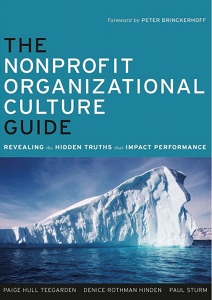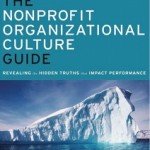Executives explore nonprofit culture, share insights
Posted by Elena del Valle on January 6, 2012

The Nonprofit Organizational Culture Guide book cover
Photos: Josey-Bass, Greg Shaler, Paige Hull Teegarden, Paul Sturm
What people say and what they do are often in conflict and so it is with the organizations where they work and that they run. Companies and organizations, like people, may unwittingly send mixed messages. One organization may tout its democratic and equitable approach toward its members while exhibiting a clearly discriminating pattern of employment toward its staff, for example.
The often unwritten organizational culture sets the tone within an organization and dictates informally the direction it takes and its parameters. Each company or organization has its own unique culture. There is, according to some experts, no single culture that is the best for everyone. On the other hand, it is important when dealing with any organization or company to be aware of and understand its culture. And, for profit and nonprofit entities are different by their very nature.

Paige Hull Teegarden, M.P.P.
There are about two million nonprofit organizations employing as many as eleven million people in the country. Although many assumptions can be made about the characteristics of a nonprofit entity often there are no clear definitions about its organizational culture. In The Nonprofit Organizational Culture Guide Revealing the Hidden Truths that Impact Performance (Josey-Bass, $40), Paige Hull Teegarden, M.P.P., Denice Rothman Hinden, Ph.D., A.C.C., and Paul Sturm, M.P.A., M.S. outline their thoughts on the topic for an audience of nonprofit leaders, managers, educators, funders and anyone seeking to understand the nonprofit sector and its effectiveness. The book required seven years of work and two publishers (the first one went out of business before publishing the book) before becoming available in December 2010.
The authors believe understanding the culture of an organization is an ongoing process that may assist those who work in or interact with the organization to be effective in orienting new staff and board members, identify leaders, define the organization’s change parameters, develop matching strategies, communicate and market with success, and find appropriate restructuring or merger choices.
“There were three big challenges. One was our inability to get financial support early on to support our research. Folks just weren’t convinced that we could reveal something that you can’t see. The second challenge was losing our publisher just before the book was going into production. The third challenge was keeping up the energy of all three authors to get the book out after seven years of trials,” said Rothman Hinden in response to a question about the biggest challenges they faced.
“Building upon the previous research and literature about organizational culture in a way that would be useful to nonprofit organizations. Prior to our book, virtually all the work and references about organizational culture had been focused on for-profit corporations,” said Sturm in response to the same question.

Denice Rothman Hinden, Ph.D., A.C.C.
The 174-page softcover book is divided into five chapters: Nonprofit Culture, Six Examples of Nonprofit Culture in Action, Revealing Organizational Culture, Reflections on Organizational Culture, and Recommendations for Nonprofit Leaders and Capacity Builders; and three appendices: Sector Informants, Organizational Culture Diagnostic Tools and About Mind Maps and Mind Mapping.
The authors propose four phases toward revealing the organizational culture process: Preparing by establishing a basic understanding of the organization and its context; identifying the organization’s objectives by finding culture stories and understanding their meaning; studying how the organization’s culture may affect the organization in achieving its objectives and developing a plan of action; and examining the ways in which change takes place within the organization in order to implement a plan.
“The encouragement and feedback we’ve received from thought-leaders and others committed to enhancing the effectiveness of nonprofit organizations and the nonprofit sector,” said Sturm when asked about the most rewarding aspect of collaborating in the book.
“Most rewarding has been demonstrating to organization leaders that there is great value in paying attention to what you can’t easily see in organizations. The book is a call to action to leaders to think about organizational experiences in a different way, and to use what they learn to create more effective management and program strategies. Helping nonprofit organization leaders think intentionally about the hidden elements of organizational culture is an important new step for strengthening organization performance,” said Rothman Hinden.

Paul Sturm, M.P.A., M.S.
Hull Teegarden, president, Think Outside, is a systems thinker with more than 15 years of experience. Rothman Hinden*, president, Managance Consulting & Coaching, has more than 25 years of nonprofit management experience. Sturm, a 25-year specialist in nonprofit leadership development and capacity building, teaches at the University of Baltimore and the College of Notre Dame of Maryland.
* The author of this note and Denice Rothman Hinden have been friends for many years.

Click to buy The Nonprofit Organizational Culture Guide










